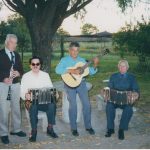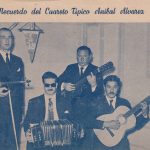Artista Aníbal Álvarez

Álvarez (1932-2009) nació en la ciudad de Paysandú. En 1939 su familia fue a vivir al pueblo Porvenir. «En pueblo Porvenir había acordeones en pila, acordeones de dos hileras […]. Había un cieguito que tocaba el acordeón que, en Carnaval, todos los años lo contrataban. […] Él tocaba en los corsos de Carnaval […]. Adornaban un carro y él con la acordeón, y toda la vuelta del corso, toda la noche. Y después un bailongo medio petisongo, que se llamaban, y tocaba. Y después otros más, Larrea, un negro que tocaba, ¡cada polca tocaba!, ¡y lindo tocaba!».[1] Ese acordeonista ciego era Emilio Rivero, a quien Lauro Ayestarán grabó en 1947 y 1954. Álvarez recuerda que en esos bailes de rancho en Porvenir, «con acordeón y guitarra bailaban hasta el otro día […] polca, ranchera, chotis, valses».[2]
En 1956, Álvarez, después de haber tocado un poco el acordeón de dos hileras, comenzó a estudiar el bandoneón. Cuenta: «Yo aprendí braille. [Estudié] en el Instituto de Ciegos General Artigas en Camino Maldonado y Libia, en Montevideo. Cinco años estudié. Aprendí música allá, solfeo (por) sistema braille».
Recuerda que en el instituto «había más profesores de piano que de bandoneón. Había un músico (bandoneonista de apellido Casales) […] del dúo Tierra Adentro, que fue muy nombrado. Tocó 20 años en Radio Rural, él aprendió allá [en el instituto]».[3]
Después de volver a Paysandú y formar un conjunto, Álvarez cuenta: «[Un colega músico] conseguía las partituras, me las dictaba, y sacaba las piezas y así fui aprendiendo el repertorio que tengo».[4]
En los bailes tocaba con su conjunto típico. Recuerda: «Éramos típica y jazz. Llevaban dos orquestas. […] Después las orquestas de jazz taparon a las típicas. […] Cumbia en cantidad se tocaba». Él cita la gran influencia del conjunto Cuarteto Imperial por el auge de la cumbia en el Uruguay y el uso del acordeón a piano en la música tropical de la década de 1960.
Esta cumbia, Río Mamoré, del Cuarteto Imperial, fue grabada en la fiesta de cumpleaños de una señora que estaba cumpliendo cien años de edad en una casa de salud, Hogar de Ancianos Enrique Chaplin, en la ciudad de Paysandú.
[1] Comunicación personal, 2002.
[2] Comunicación personal, 2002.
[3] Comunicación personal, 2002.
[4] Comunicación personal, 2002.
Álvarez (1932-2009) was born in the city of Paysandú and in 1939 his family moved to the nearby town of Porvenir. He remembers that, «In Porvenir there were a lot of accordions […] There was a blind guy who played the accordion who was hired to play at every Carnaval […] they would decorate a horse-drawn wagon and take him around on it playing accordion in the parade all night, and then he would play in the bailongos[1] at night. And there was a black guy named Larrea who played some great polcas».[2] The blind accordionist was Emilio Rivero who was recorded by musicologist Lauro Ayestarán in 1947 and 1954. Álvarez remembers that in those humble house parties in Porvenir «people would dance polca, ranchera, chotis, valses played on button accordion and guitar until the sun came up».[3]
In 1956, after playing a bit on the button accordion, Álvarez began to study the bandoneon. He stated, «I learned by Braille in the Instituto de Ciegos General Artigas (General Artigas School for the Blind) on Camino Maldonado and Libia in Montevideo, I studied there five years. I learned to read music with the Braille system».
He remembered that at the school, «there were more piano teachers than bandoneon teachers. There was a musician […] from the famous Dúo Tierra Adentro, who played twenty years straight on CX4 Radio Rural (bandoneonist of the last name Casales)».[4]
After returning to Paysandú and forming an ensemble, Álvarez recalled, «[A musician friend of mine] would get the sheet music and he would dictate it to me, I learned the songs that form the repertoire that I have now».[5]
In the dances that he would play with his típico ensemble, «we were típica y jazz. They always had two different bands. […] Later the jazz bands overtook the típico groups. […] They played a lot of cumbia». He cites the powerful influence of the Cuarteto Imperial in the popularization of cumbia in Uruguay and the use of piano accordion in tropical music in the 1960´s.
This cumbia, Río Mamoré, by the Cuarteto Imperial, was recorded at the 100th birthday party of a lady in the retirement home, Hogar de Ancianos Enrique Chaplin, in the city of Paysandú.
[1] Regional term for social dance party.
[2] Personal communication, 2002.
[3] Personal communication, 2002.
[4] Personal communication, 2002.
[5] Personal communication, 2002.
Colecciones (2)
Colección 7. Intersecciones entre música típica y popular / Intersections between típica and popular music
En esta sección aparecen intersecciones entre la música típica y la música popular. En el norte de Uruguay, por ser…


